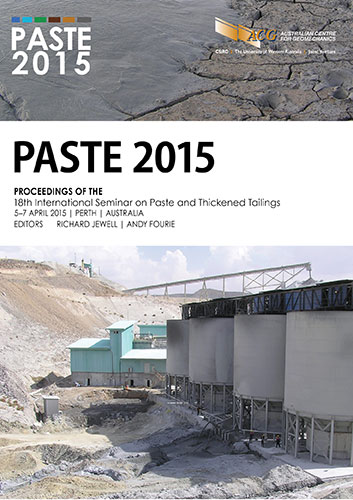The impacts of using thickened tailings on water management and CAPEX of tailings storage facilities

|
Authors: Fabian, K; Jacobs, M; Hooshiar, A; Ngwenya, E |
DOI https://doi.org/10.36487/ACG_rep/1504_41_Fabian
Cite As:
Fabian, K, Jacobs, M, Hooshiar, A & Ngwenya, E 2015, 'The impacts of using thickened tailings on water management and CAPEX of tailings storage facilities', in R Jewell & AB Fourie (eds), Paste 2015: Proceedings of the 18th International Seminar on Paste and Thickened Tailings, Australian Centre for Geomechanics, Perth, pp. 535-546, https://doi.org/10.36487/ACG_rep/1504_41_Fabian
Abstract:
The primary goal of water management at mines in arid areas is to minimise the use of surface water and groundwater (natural water) in the mining process. Typical natural water issues include lack of water; access issues due to legal, community, logistic or regulatory reasons; groundwater drawdown; and nearby community and farming impacts. In some cases, large-distance, high-head pumping and/or desalinated water are required, significantly increasing capital and operation expenses (CAPEX and OPEX). A method of reducing natural water demand is the use of thickened tailings (TT) and paste tailings (PT) technologies, where water is returned from the process plant, minimising discharge to the tailings storage facility (TSF), reducing pumping demand and costs, and thus OPEX. Added benefits of TT and PT include reduced evaporation and seepage losses, further improving water re-use, and reducing impact to groundwater. An important consequence of the use of TT or PT is an increase of the initial density of tailings discharged to the TSF. This will result in a smaller volume (i.e. lower void ratio) of tailings discharged, therefore less TSF storage capacity required. This can lead to a smaller TSF footprint, and/or lower dam height. Either way, the dam volume is less, and thus the TSF CAPEX is less and the dam can be constructed faster. This paper discusses the current and planned future TSF operations at Goldcorp’s Minera Peñasquito in Mexico. It describes a site water management/balance model and, in particular, the TSF component, and presents natural water demand based on current sand-slime-splitting of tailings. The paper also describes changes to the model and natural water demand reflecting a plan to change tailings discharge from cyclones to TT. The main parameters affecting the model are discussed, including results of column settling and constant rate of strain tests to develop initial and final density and void ratio values, and how they affect the volume of tailings discharged and TSF storage capacity required. The paper further discusses the change in the rate of tailings rise, reducing by approximately 22% per annum over about the same TSF footprint, after the tailings operation changes to TT technology. The effect on the total storage volume and overall dam volume are discussed, demonstrating that the change to TT reduces the required dam volume by 30%, and results in significant CAPEX savings for the TSF expansion.
References:
ASTM International 2012, ASTM D 4186 – Standard Test Method for One-Dimensional Consolidation Properties of Saturated Cohesive Soils Using Controlled-Strain Loading, ASTM International, West Conshohocken.
ASTM International 2012, ASTM D 5856 – Standard Test Method for Measurement of Hydraulic Conductivity of Porous Material Using a Rigid-Wall, Compaction-Mold Permeameter, ASTM International, West Conshohocken.
Golder Associates 2012, Water/Tailings Project Site-Wide Water Balance Analysis Model – Revision 0, technical memorandum, completed confidentially for Goldcorp, 10 December 2012, Golder Associates.
Golder Associates 2013, Peñasquito Mine Water Tailings Project Optimization Study, completed confidentially for Goldcorp, February 2012, Golder Associates.
Golder Associates 2014, Minera Peñasquito Trade-Off Study, Golder Associates.
URS Corporation 2014, Pre-feasibility Study Report, Minera Peñasquito Tailings Storage Facility Replacement Project, completed confidentially for Goldcorp, September 2014, URS Corporation.
© Copyright 2025, Australian Centre for Geomechanics (ACG), The University of Western Australia. All rights reserved.
View copyright/legal information
Please direct any queries or error reports to repository-acg@uwa.edu.au
View copyright/legal information
Please direct any queries or error reports to repository-acg@uwa.edu.au